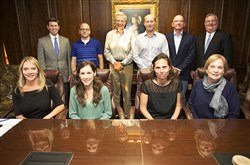VOL. 39 | NO. 44 | Friday, October 30, 2015
Developers, residents work together for Green Hills
By Linda Bryant

Members of the Alliance for Green Hills are, back row from left, John Lowry, Michael Hasty, Ed Cole, Michael McNally, Brent Smith, Trey Rochford. Seated from left: Jena Armistead, Elizabeth Miller, Susannah Scott-Barnes, Charlotte Cooper.
-- Michelle Morrow | The LedgerThe Alliance for Green Hills is a new model for a neighborhood organization in Nashville.
You might call it a neighborhood “supergroup.”
The organization announced a powerhouse board of directors in August that included some former adversaries who fought bitterly over 4000 Hillsboro, Southern Land Co.’s $125 million mixed-use project at the corner of Richard Jones Road and Hillsboro Pike.
The Green Hills Neighborhood Association sued Southern Land over the 18-story project, claiming it was in violation of Metro zoning regulations that govern building heights. The state Court of Appeals affirmed a lower-court ruling in favor of Southern Land in June, and the Green Hills Neighborhood Association against the legal route.
Charlotte Cooper, president of the group that sued Southern Land, is now on the board of directors of the Alliance for Green Hills. On that board she sits alongside two representatives from Southern Land – McNally, the company’s vice president of mixed-use development, and Jena Armistead, Southern Land’s vice president of marketing.
Ed Cole, president and former executive director of the Transit Alliance of Middle Tennessee, is president of the new group.
Other directors include Steve Horrell, who heads up the Horrell Co., a commercial real estate firm; local developer Brent Smith; Susannah Scott-Barnes, co-owner of AshBlue; neighborhood advocates Elizabeth Miller and Stacy Doris Proctor. Other board members include Carey Morgan, Michael McNally and Michael Hasty.
“Changes are coming and some of them will not be exactly what we, as individuals, might have chosen,” Cooper says. “However, the spirit of collaboration and compromise involves a recognition that we all give up a little to gain a lot together.”

Downey
Southern Land helped launch the Alliance for Green Hills with a $100,000 donation. Cooper says the group is strongly focused on listening to everyone at the table, not just the strongest monetary contributor.
Southern Land CEO Tim Downey agrees.
“The Alliance for Green Hills and Southern Land Company’s mission and values are similarly aligned – to create a better, more beautiful Green Hills,” Downey explains.
Cooper offered the following response to The Ledger’s questions on behalf of the entire Alliance for Green Hill’s board.
How and why was the Alliance for Green Hills formed?
“Over the last 10 years or so, Green Hills has experienced many changes. The commercial area is growing, development is pushing higher density, and the older residential neighborhoods are taking on a different look.
“Many residents were feeling left out of the decision-making process as to how our community would change. In fact, there was growing resentment between the residents and the developers. Several neighborhood leaders started meeting with some business owners and developers to see if we could discuss and perhaps negotiate a consensus of how our community should grow.
“We decided our vision should be to unify neighborhood stakeholders (all stakeholders, including residents/business owners/developers). We wanted to make Green Hills a better place for all. We have been meeting for about a year now, and we recently filed our organization’s charter. In other words, the Alliance for Green Hills is a response to the incredible pace of change happening in this neighborhood and across the city. In short, we have a shared vision of building a better Green Hills for all, and we must collaborate and compromise to get there.”
How did you decide on the members of the board? What kind of membership are you attracting?
“Basically, to get things started, we decided those individuals who had been showing up at the meetings and were involved should be on the initial Board. We wanted the board to be balanced.

“… we are fully engaged in the community involvement process surrounding the planning for a new or renovated Hillsboro High School.”
-- Michelle Morrow | The Ledger“As we worked on our bylaws, we specified the numbers and the different groups that should comprise the board. Our membership is diverse. We have Green Hills residents, business owners and developers; we have nearly 150 on the mailing list. We have adopted an “open” membership policy. All who are interested in working together to help frame the future of Green Hills are welcome.”
What are your main goals?
“I think everyone agrees the biggest problem in Green Hills is traffic. We need solutions. Green Hills is unique in that we developed organically; our commercial district started out small to accommodate the neighboring residents. We have one arterial road, Hillsboro Pike; we are about a mile from I 440; we have a very desirable mall that attracts shoppers from Middle Tennessee and beyond; commercial and office space is highly sought after, as is our residential neighborhoods.
“Traffic, density, and growth are our main problems. With these come other issues – lack of complete sidewalks, lack of community spaces, no continuity of design (sort of a hodgepodge look), and we have few tax dollars put back into our community for infrastructure improvements. We have three transit routes running into and out of Green Hills, yet those buses are empty for the most part.
“It is difficult to safely walk in Green Hills. We have too many curb cuts on Hillsboro Pike, requiring driving a car from one business to another instead of walking, and we have two dogleg intersections we would like to see straightened. It would be nice to have a small circulator bus in Green Hills that would help cut down on driving from one business to another or from the mall or Hill Center to the library or post office. We need solutions to keep some of the cars off the streets.
“A strong link with traffic is transportation. Within that challenge is an opportunity to synthesize several solutions to reach our goal. Consider an internal circulator trolley, safer crosswalks and better signage for pedestrians and bikers. These improvements would likely encourage people to walk, but where would they go? We currently have no open green space in or near the core of Green Hills; if walking, there are no park benches to sit down and rest, or even public trash containers for discarded cups or food wrappers.
“Green Hills does not encourage walking, yet we could and we should. Link the sidewalks to open, beautiful, community spaces, and you have a reason to leave the car at home. Of course, we also need to consider the sense of community that motivates people to seek out the company of others. All of this community-building perpetuates more investment and involvement into the question of how to get from here to there. Transportation is not a separate issue from creating access to desirable community spaces. These factors work together to create a better neighborhood for all.”
Have you identified specific improvements and/or prioritized them?
“The group has identified large-scale and small-scale improvements, all of which center on making Green Hills a more complete community.
“We will also focus on specific areas of Green Hills where discussions of future development are occurring. Right now, we are fully engaged in the community involvement process surrounding the planning for a new or renovated Hillsboro High School. We are interested in the future of the property that will be vacated when the new fire station is completed. We are listening to ideas and plans for new development projects, both residential and commercial.
“We will be working closely with Metro as decisions are made to implement the development principles found within the recently-adopted NashvilleNow plan.
“Finding the right solutions to our problems will help with our mission to implement community improvements, be pedestrian friendly, create open, community spaces, beautify the commercial core and in general build a better Green Hills for everyone.”
What kind of power does a group like this have?
“If we can accomplish our vision and our mission, we believe we will gain respect and authority. I think the power of the group is its collaborative approach to viewing the challenges facing the neighborhood. Our power will come from our accomplishments, when we succeed, the organization will have power to influence decisions about our growth and improvements.
“And yes, changes are coming and some of them will not be exactly what we, as individuals, might have chosen. However, the spirit of collaboration and compromise involves a recognition that we all give up a little to gain a lot together. Success for this group, so far, is its role as a sounding board for the residents, developers, businesses and government leaders. Power is uniting all of these voices to work towards the common purpose of building a better neighborhood for all.”
What has the response been to your formation?
“We have received a lot of positive feedback. One individual asked if we would share our business plan with other communities. If we are successful, yes we will be happy to share our plan. A few outside of Green Hills saw this as just another organization for the development community. But what we want everyone to understand is that our organization is not just for developers, but for all stakeholders.
“Our organization welcomes anyone who lives, works, develops or owns property in Green Hills to join. We are pioneers, hoping to create a better community, but it will take all of us to accomplish our vision that is to unify neighborhood stakeholders, create beautiful, functional spaces, and build a better Green Hills for all.”